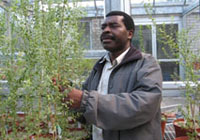
Phone: 021 650 2964
Email: Samson.Chimphango@uct.ac.za
Room No.: 4.13, (HW Pearson Building)
Research Interests
I am interested in understanding the physiological mechanisms of plant (especially legumes) adaptation to extreme edaphic conditions and climate change. Legumes are known to be high resource (nutrient) demanding for plant growth and biological nitrogen fixation. And yet, legumes are found in most of the ecosystems of the world including those with infertile and acid soils. The ability of legume species and their micro-symbiont to function under extreme conditions is quite amazing to me. Additionally, I also study the influence of edaphic factors on the biogeography of legumes in an area and domestication of native legumes as pasture crops.
Key Research Categories
- Legume adaptation to extreme edaphic factors and climate change
- Ecophysiology of legumes
- Legume biogeography –role of edaphic factors
- Phosphorus nutrition in legumes
- Economic use of native legumes as pasture crops
- Estimation of N2 derived from atmospheric fixation by symbiotic legumes in natural and agricultural ecosystems
- Enhancing biological N2 fixation in agricultural systems by exploiting legume genotypes and their microbial symbionts
- Minimisation of use of inorganic fertiliser in Agriculture by promoting soil microbial activity in:
- Biological nitrogen fixation
- Mycorrhizal effect
- Organic matter decomposition
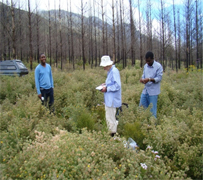
|
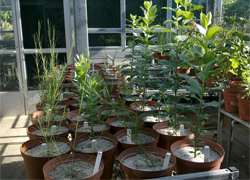
|
Main Research Projects
Thermotolerance genotypes for sustainable legume production in South Africa. The project is aimed at identifying thermotolerance traits and legume genotypes with desirable agronomic traits.
Increasing rangeland grazing potential for livestock farming in the Overberg Renosterveld, South Africa. This project is aimed at assessing the impact of grazing on species diversity and composition and characterizing native legume and non-legume grazing species to categorize palatable species.
The role and tolerance mechanisms of indigenous N2 fixing legumes in the acidic and low P environment of the Western Cape Floristic Region, South Africa.
The role of edaphic factors in the biogeography of legumes in the Cape Floristic Region
Rhizobia diversity in the Cape Floristic Region
Assessing soil fertility status in rooibos tea cultivation at Nieuwoudtville, Northern Cape, South Africa
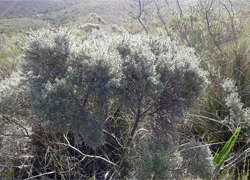
|
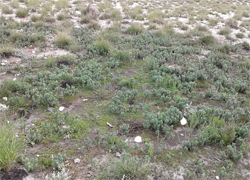
|
Student Supervision
- Tonny Selinga (PhD Student, registered February 2016): PhD titled “Thermotolerance in South African cowpea genotypes to heat stress associated with climate change”. Supervisor
- Dunja MacAlister (PhD Student, registered February 2016): PhD titled “Thermotolerance in Aspalathus linearis (Burm. f. ) R. Dahlgren”. Supervisor
- Jannie Groenewald (PhD student, registered February 2015): PhD titled Floristic composition and ecology of Quartz fields in the Overberg Renosterveld, South Africa. (Co-supervisor)
- Francuois Muller (PhD Student, registered with UWC, February 2015): Native legume species from the Northern Cape Province of South Africa and their potential use as forage crops (Co-supervisor)
- Zoe Poulsen (PhD Student, registered February 2014): PhD project titled “Conserving living landscapes and sustaining rural livelihoods: Investigating impacts of livestock grazing and assessing rangeland restoration potential in critically endangered Overberg Renosterveld”. (Supervisor)
- Luke Gallant (MSc Student, registered with UWC February 2014): MSc project titled “Characterizing native palatable legume and non-legume species in the rangelands of the Overberg Renosterveld”. (Supervisor)
- Kolisa Yola Sinyanya (MSc Student, submitted for examination, February 2013): MSc project titled “Symbiotic nitrogen fixation of rhizobia isolated from low P soils of the Cape Floristic Region”. (Supervisor)
- Ntwai Moiloa (MSc student, submitted for examination, February 2013) MSc project titled “Is Wiborgia (Fabaceae) biogeography determined by available soil rhizobia in the Greater Cape Floristic Region? (Co-supervisor)
- Meshack Dludlu (PhD student registered February 2013): PhD project titled “The Biogeography of legumes and rhizobia in the Cape Peninsula of South Africa. (Co-supervisor)
- Abubakar Bello (PhD student, submitted for examination, February 2013): PhD project titled “Taxonomic and evolutionary studies of the genus Psoralea (Fabaceae). (Co-supervisor)
- Dunja Basic (MSc student, Graduated June 2015): MSc project titled “Phosphorus uptake in cluster root and non-cluster root forming species indigenous to the Cape Floristic Region. (Supervisor)
- Pravin M Maistry (PhD student, Graduated June 2015): PhD project titled “Enhanced P acquisition strategies and symbiotic N2-fixation in low P adapted Aspalathus and Podalyria species indigenous to the Cape Floristic Region”. (Supervisor)
- Gardia Potgieter (MSc student, graduated December 2013): MSc project titled “N and P limitation of legumes and non-legume plants of the Cape Floristic Region, South Africa. (Supervisor)
- Rabelani Munyai (MSc student, graduated June 2013): MSc project titled “Are old monotypic Cape lineages genetically abd ecologically impoverished? A case study of Prionium. (Co-supervisor)
- Oscar Dlodlo (MSc student, graduated December 2012): MSc project titled “Characterization of rhizobia isolated from nodules of indigenous legumes and their effect on host plant distribution in the Cape Floristic Region, South Africa. (Supervisor)
- Stefan Milandri (MSc student, graduated December 2012): MSc project titled “An investigation into the ability of vegetated biofilters to treat stormwater in the City of Cape Town, South Africa. (Co-supervisor)
- Aluwani Tshiila (MSc student, graduated December 2012): MSc project titled “Systematic studies of the Ficinia Clade (Cyperaceae). (Co-supervisor)
- Meshack Dludlu (MSc student, graduated December 2010): MSc project titled “Systematics of the genus OtholobiumH. Stirton (Leguminosae)”. (Co-supervisor)
- Simon Power (MSc student, graduated December 2010): MSc project titled “Do ecophysiological traits of legumes account for their lack of persistence in late-successional post-fire CFR?” (Supervisor)
- Pravin M Maistry (MSc student, graduated on 4th June 2010): MSc project titled “An investigation of phosphorous constraints on biological nitrogen fixation (BNF) in indigenous legumes adapted to the infertile soils of the Cape Floristic Region”. (Supervisor)
- Joachim Makoi (PhD student, graduated March 2010): PhD project titled “Assessing flavonoid concentration in cowpea genotypes and the effect of plant density on growth, N2-fixation and rhizosphere phosphatases and grain yield of cowpea intercropped with sorghum” Cape Peninsula University of Technology. (Co-supervisor)
Publication - Peer reviewed
- Lemaire B, Van Cauwenberghe J, Chimphango S BM, Stirton CH, Honnay, O, Smets E, Muasya AM. 2015. Recombination and horizontal transfer of nodulation and ACC deaminase (acdS) genes within Alpha-and Betaproteobacteria nodulating legumes of the Cape Fynbos biome.FEMS Microbiology Ecology, 91(11), 1-8.
- Lemaire B, Dlodlo O, Chimphango SBM, Stirton CH, Schrire B, Boatwright S, Honnay O, Smets E, Sprent J, James E, Muasya, AM. 2015. Symbiotic Diversity, Specificity and Distribution of Rhizobia in Native Legumes of the Core Cape Subregion (South Africa). FEMS Microbiology Ecology 91(2) 1-17
- Bello A, Stirton CH, Chimphango SBM, Muasya AM. 2015. Psoralea diturnerae and vanberkelae (Psoraleeae, Fabaceae): two new species restricted to the Core Cape Region of South Africa. PhytoKeys 44, 97-107.
- Bello A, Daru BH, Stirton CH, Chimphango SBM, van der Bank M, Maurin O, Muasya AM. 2015. DNA barcodes reveal microevolutionary signals in fire response trait in two legume genera.AoB Plants, 7, plv124
- Dludlu MN, Muasya AM, Chimphango SBM, Stirton CH. 2015. Taxonomy of the Southern African Psoralea aphylla complex (Psoraleeae, Leguminosae). South African Journal of Botany 97, 77-100.
- Maistry PM, Muasya AM, Valentine AJ, Chimphango SBM. 2015. Balanced allocation of organic acids and biomass for phosphorus and nitrogen demand in the fynbos legume Podalyria calyptrate. Journal of Plant Physiology 174, 16-25. DOI.ORG/10.1016/J.JPLPH.2014.10.005.
- Maistry PM, Muasya AM, Valentine AJ, Chimphango SBM. 2015. Increasing nitrogen supply stimulates phosphorus acquisition mechanisms in the fynbos species Aspalathus linearis. Functional Plant Biology 42, 52-62.. DOI.ORG/10.1071/FB14100
- Chimphango SBM, Potgieter G, Cramer MD. 2015. Differentiation of the biogeochemical niches of legumes and non-legumes in the Cape Floristic Region of South Africa.Plant Ecology 216, 1583-1595.
- Makoi JHJR, Chimphango, S. B. M. Dakora, FD. 2014. Changes in rhizosphere concentration of mineral elements as affected by differences in root uptake and plant growth of five cowpea genotypes grown in mixed culture and at different densities with sorghum. American Journal of Experimental Agriculture, 4 (2): 193-214
- Maistry PM, Cramer MD, Chimphango SBM. 2013. N and P colimitation of N2-fixing and N-supplied fynbos legumes from the Cape Floristic Region. Plant and Soil 373, 217-228. DOI 10.1007/s11104-013-1793-y.
- Dludlu MN, Stirton CH, Chimphango SBM, Bello A, Muasya AM. 2013. Phylogenetic position of the southern African members of the tribe Psoraleeae based on molecular and morphological data. South African Journal of Botany, 89, 150-155. DOI/10.1016/j.sajb.2013.06.019.
- Chimphango SBM, Musil CF, Dakora FD. 2012. Alteration in the mineral nutrition of purely symbiotic and nitrate-fed nodulated legumes exposed to elevated UV-B radiation. Journal of Plant Nutrition 35, 1-20.
- Milandri SG, Winter KJ, Chimphango SBM, Armitage NP, Mbui DN, Jackson GE, Liebau V. 2012. The performance of plant species in removing nutrients from stormwater in biofiltration systems in Cape Town. Water SA 38, 655-662.
- Power SC, Cramer MD, Verboom GA, Chimphango SBM. 2011. Legume seeders of the Cape Floristic Region inhabit more fertile soils than congeneric resprouters - sometimes. Plant Ecology 212, 1979-1989.
- Makoi JHJR, Chimphango SBM, Dakora FD. 2010. Photosynthesis, water-use efficiency and δ13C of five cowpea genotpyes groan in mixed culture and at different densities with sorghum. Photosynthetica 48, 143-155
- Makoi JHJR, Chimphango SBM, Dakora FD. 2010. Elevated levels of acid and alkaline phosphatase activity in roots and rhizosphere of cowpea (Vigna unguiculata L. Walp) genotypes grown in mixed culture and at different densities with sorghum (Sorghum bicolour L. Moench). Crops and Pasture Science 61, 279-286.
- Power SC, Cramer MD, Verboom GA, Chimphango SBM. 2010. Does phosphate acquisition constrain legume persistence in the fynbos of the Cape Floristic Region? Plant and Soil, 224, 33-46.
- Makoi JHJR, Chimphango SBM, Dakora FD. 2010. Seed flavonoids and anthocyanins as markers of enhanced plant defence in nodulated cowpea (Vigna unguiculata L. Walp). Field Crops Research, 118, 21-27.
- Makoi JHJR, Chimphango SBM, Dakora FD. 2009. Effect of legume plant density and mixed culture on symbiotic N2 fixation in five cowpea genotypes in South Africa. Symbiosis 48, 57-67.
- Naab JB, Chimphango SBM, Dakora FD. 2009. N2 fixation in cowpea plants grown in farmers’ fields in the Upper West Region of Ghana, measured using 15N natural abundance. Symbiosis 48, 37-46.
- Dakora FD, Chimphango SBM, Valentine AJ, Wlmerich C, Newton WE (Eds.). 2008. Biological Nitrogen Fixation: Towards Poverty Alleviation through Sustainable Agriculture. Proceedings of the 15th International Nitrogen Fixation Congress and the 12th International Conference of the African Association for Biological Nitrogen Fixation, 21-26 January 2007, Cape town, South Africa. Current Plant Sciences and Biotechnology in Agriculture, Vol. 42. Springer, New York, USA.
- Chimphango SBM , Brown CF, Musil CF and Dakora FD. 2007. Effects of elevated UV-B radiation on seed yield of Glycine max and an assessment of F1 generation for carryover effects. Physilogia Plantarum 131, 378-386.
- Cramer MD, Chimphango SMB, van Cauter A, Waldram Matt, Bond WJ. 2007. Grass competition induces N2 fixation in some species of African Acacia. Journal of Ecology 95, 1123-1133.
- Chimphango SBM , Musil CF and Dakora FD (2004) Response to ultraviolet-B radiation by purely symbiotic and NO 3-fed nodulated tree and shrub legumes indigenous to Southern Africa. Tree Physiology24, 181-192.
- Chimphango SBM , Musil CF and Dakora FD (2004) Impact of increased ultraviolet-B radiation stress due to stratospheric ozone depletion on N 2 fixation in traditional African commercial legumes. South African Journal of Botany70, 790-796.
- Chimphango SBM , Musil CF and Dakora FD (2003) Effect of ultraviolet-B radiation on plant growth, symbiotic function and concentration of metabolites in three tropical legumes. Functional Plant Biology30, 309-318
- Chimphango SBM , Musil CF and Dakora FD (2003) Response of purely symbiotic and NO 3-fed nodulated plants of lupinus luteus and vicia atropurpurea to ultraviolet-B radiation. Journal of Experimental Botany54, 1771-1784.
- Musil CF, Kgope BS, Chimphango SBM and Dakora FD (2003) Nitrate additions enhance the photosynthetic sensitivity of a nodulated South African Mediterranean-climate legume ( Podalyria calyptrata) to elevated UV-B. Environmental and Experimental Botany50, 197-210.
- Musil CF, Chimphango SBM and Dakora FD (2002) Effects of elevated Ultraviolet-B radiation on native and cultivated plants of Southern Africa. Annals of Botany 90, 127-137.
